Corrugated Box vs. Wooden Crate vs. ATA Case vs. Molded Shipping Case
4 April 2023
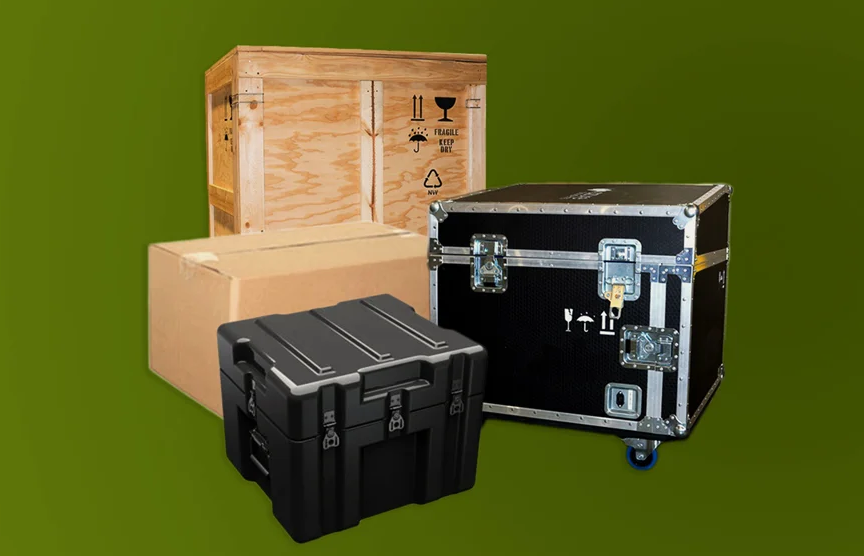
Do you know which is the best shipping container for your application?
When shipping or storing valuable and sensitive high-tech equipment how do you know whether you need a corrugated box, crate, ATA case, or molded shipping case? This guide will help you understand some of the differences between each product. You are not just buying a package—you are buying a solution to your problem.
Some important questions to consider
The answer to these questions will influence what kind of packaging will be most useful for your application.
- Protection/Safety – How sensitive or delicate is your equipment?
- Size/Weight/Uniqueness – How big is your item? How much does it weigh? How will it be handled? Is it odd shaped or does it have arms, hoses, protrusions, or fragile components?
- Fragility – How sensitive is it to shock and vibration?
- Material Handling – does it need to be carried or moved by a person, or are pallet jacks or forklifts available? Is a loading dock available at the origin and destination? What equipment is available there? Will the packaging be kept or disposed of? How?
- Shipping Method – Will it be transported by air, ocean, or truck, or in the back of a car? What is the environment like that can impact handling, size/weight restrictions, and shock and vibration?
- Ease of Use – How will the package be loaded and unloaded? How will it be handled? How important is it to have tools or avoid tools? How much does loading/unloading time cost you? Do you need it standard or customized?
- Aesthetics – Is premium look important to you? Does the packaging need to make a strong impression, perhaps at a tradeshow or other type of public presentation? Or does it just need to get there and work?
- Reusability – How many trips does this need to make? Do you plan to reuse your packaging? How many times and how often will your item need to be shipped?
- Cost Per Package or Cost Per Trip – Are you open or looking for closed loop logistics and multiple trips or for a disposable one-way option? Are you comparing apples to apples even among types of product? (not all packaging products are designed or built the same)
Jump to
Features Comparison | Corrugated Box | Wooden Crate | ATA Case | Molded Case
Features Comparison
| Corrugated Box | Wooden Crate | ATA Case | Molded Case | |
|---|---|---|---|---|
| Up Front Cost | Low $ per/unit | Moderate $$-$$$ per/unit | Higher $$$$ per/unit | Higher $$$$ per/unit |
| Strength and Capacity | ||||
| Durability/Protection Ability to withstand external impact and shock and protect the product inside during transit. | • | • • • | • • • • | • • • • |
| Weight Capacity How much weight the container type can typically hold. | Up to 125 lbs. | 125 lbs. – Unlimited | 50 lbs. – 400+ lbs. | 10 lbs. – 250 lbs. |
| No. of Trips How many trips the container type is typically suited for carrying products. | 1 | 10 | 100 | 100 |
| Cost per Trip The total cost per trip is based on the initial unit cost divided by the number of trips it is actually used for. | (Flat) | (Declines if reused) | (Declines with each use) | (Declines with each use) |
| Material Handling | ||||
| Ease of Use How easy it is to use in terms of loading and unloading the contents and sealing, and whether special tools are required. | Easy | Somewhat Difficult | Easy | Easy |
| Ease of Transport Ease of handling, loading and unloading on trucks, etc. | Very Easy | Somewhat Difficult | Somewhat Easy | Easy |
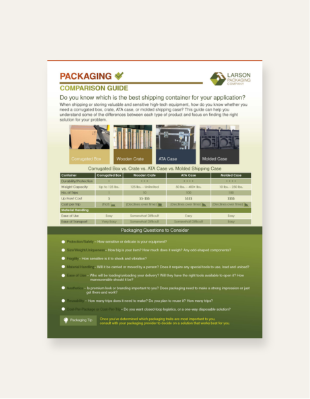
A Complete Guide to Packaging Types
Download a PDF version of this comparison guide.
Looking Closely at the Products

Corrugated Box
What it is: Corrugated boxes are the most popular type of single-use packaging, and they are made from corrugated fiberboard or plastic. Corrugated boxes may also include foam-cushioned interiors to house and protect products inside them. The foam cushioning provides blocking and bracing against shock and vibration. Different types of foam can be used based on your application, the fragility, weight, and dimensions of your equipment.
Why it is used: As the most popular type of packaging, a corrugated box is a hassle-free solution. No special tools are required to open it and using it is relatively straight-forward. Boxes are also easy to dispose of and can be recycled. It’s easy to obtain bulk corrugated packaging while keeping inventory low since repeated orders can be rapidly fulfilled on-demand.
Corrugated is lightweight and versatile—it can be combined with other substrates to optimize for cost, weight, and performance.
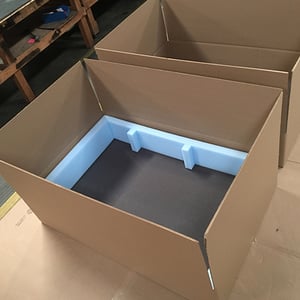
Because it is less expensive, it also offers the best protection-to-cost ratio of any outer packaging. However, it is limited in the amount of protection it provides.
How it is used: Corrugated boxes are typically used for 1x shipments and for products that only need a minimal amount of protection in transit. For added support, a corrugated box can be used as a cap on a pallet base, which reinforces stability while keeping costs low. Boxes can be custom designed for almost any application, and waterproof plastic corrugated is a great solution for medium-term storage in challenging environments (such as clean rooms, near water, etc.) or where multiple use is desired.
Drawbacks: The most significant negative aspect of corrugated packaging is that it offers only a very limited amount of protection against the elements and is easily ruined by water or rough handling. It also typically offers lower weight capacities than other types of packaging. Corrugated boxes are not designed to be reused. But since they are less expensive, they are also a more disposable solution in general.

Wooden Crate
What it is: Wooden crates are wooden containers scientifically engineered to precisely enclose and protect equipment from external forces and shock. Far more than just a plywood box, wooden crates can be carefully engineered and tested to provide specific amounts of mitigation for shock and vibration.
Why it is used: Wooden crates are highly customizable and sturdier than corrugated boxes. Most designs meet Mil-Spec and ASTM standards for quality and protection. Wooden crates can also be reused and refurbished to extend their lifetime, which can help make them more cost-effective. Since wooden crates are less expensive than ATA and polymer plastic cases like Pelican and SKB, they are attractive for situations where the number of trips needed to be used is relatively low and the amount of protection needed is high.
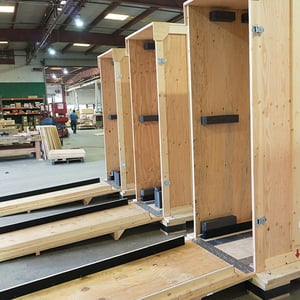
Wooden crates can always be constructed to handle more weight which is why there is virtually no weight limit. Thanks to high engineering and testing standards, wooden crates can be built to withstand rough conditions and provide a high degree of protection to contents inside.
How it is used: Wooden crates are typically used for moving heavy and delicate products and sensitive items that require special handling in transit. Examples include server racks, medical equipment and robotic arms, and other types of awkward, heavy equipment. Large items that need engineered shock protection and support will usually require a wooden crate. Corrugated packaging can also be combined with wooden crates into a hybrid solution for cost-efficiencies where less than full-scale protection is needed. Wooden crates should be designed to last multiple trips with basic refurbishment.
Drawbacks: Of all the different packaging types, wood packaging is the most heavy. This also makes it more difficult to handle and load and unload. Most crates require lifting equipment (such as forklifts) to move or special tools to open. Additionally, as a consideration for international shipping, some destinations have particular phyto-sanitary requirements, such as heat-treated wood for overseas transport. Learn more about ISPM standards for international shipping.

ATA Case
What it is: ATA cases, also known as road cases or transit cases, are customizable studry containers with modifiable features for easy and repeated transport. Originally developed for use in the airline industry to easily send parts and avionics, the ATA 300 specification details construction and use of at least 100 roundtrips. ATA cases can be assembled using three types of materials, which you can learn more about here.
Why it’s used: ATA cases are easy to use and move around, usually including handles and sometimes casters for moving around on four wheels. Additionally, they can be opened and closed with custom latches and include hinged lids for easy access to contents inside. ATA cases are studier than other types of packaging (such as corrugated) and are designed to be used over and over again. They are also very customizable and can be adapted easily for different functions and situations, including acting as a permanent outer “shell” for technology that never leaves the case (monitors, rack units, etc.).
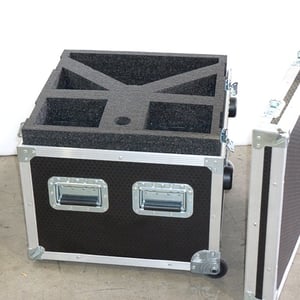
They are also very customizable and can be adapted easily for different functions and situations. ATA cases can be designed and manufactured to accommodate irregular sized objects and complex subassemblies that might require a drawer or additional storage inside the case. In addition, ATA cases are great for long-term storage, and with minor modifications, they can reduce or eliminate the need for material handling equipment.
How it’s used: Products that can be compactly stored and need durable protection often have need for an ATA case, particularly if transported frequently. Production and event companies typically use ATA cases to carry lights, electronics, and musical equipment that will be used on the road. When ease of use and transportation is a high priority for electronics and other types of gear that needs rigid protection, an ATA case will usually get the job done. Also, for events like tradeshows where a premium packaging look and aesthetic appeal are important for presentation, custom ATA cases can be ideal.
Drawbacks: Because ATA cases are designed using such durable materials, they are also typically more expensive than other types of packaging. If your equipment needs highly durable packaging, but it will not be transported regularly, you may simply need a wood crate that can be used only a few times. Internal components of ATA cases are also more difficult to repair, though they are less likely to wear out as quickly overtime. ATA cases are difficult to dispose of and recycle—if the need ever arises!
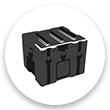
Molded Shipping Case
What it is: Durable packaging made from high-strength polymer resin, adapted to many use cases. Some of the most recognized brands are Pelican, Pelican-Hardigg and SKB. These cases have multiple sizes and styles that can be injection-molded or roto-molded and include many different customization options.
Why it is used: A molded shipping case, like Pelican or SKB, is designed to be highly protective and easy to use. It is ideal for items that are not as heavy, but require strong protection and ease of handling and storage. Pelican and SKB cases are resistant to many elements—weatherproof, dustproof, and have a lifetime guarantee. Since they are gasket-sealed, they are designed to keep out unwanted hazards like water and dust. Built to meet or exceed military specifications, these are some of the toughest cases on earth.
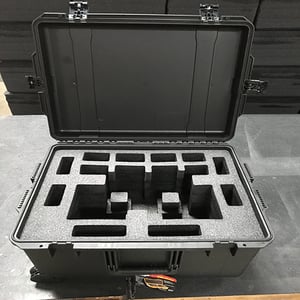
How it is used: Polymer plastic molded cases are designed for use in the field in a number of different industries, such as scientific and medical instruments, aerospace parts and avionics military weaponry and tools, deployment kits, platoon kits, and others. Custom foam interiors can be designed for internal protection against shock damage, making these cases ideal for equipment like thermal imaging, cameras and communications gear. Custom toolkits, medical supplies and first aid, law enforcement equipment and the like are often housed in Pelican or SKB cases that are lighter weight and provide crush-resistant protection. Systems and instruments can also be integrated into molded cases so they become part of the product themselves, such as rack cases, which turn into mobile units that are easy to transport and deploy.
Drawbacks: Pelican and SKB cases come in standard sizes and are not as easily modified for custom solutions, although they can be outfitted with customized foam interiors to fit, organize, and protect different types of products. These polymer plastic cases are also not biodegradable or easily recycled, but they are generally used longer than other types of recyclable packaging like wood crates or corrugated boxes.
